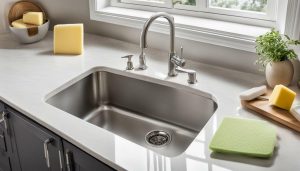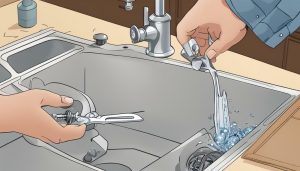When it comes to installing or replacing kitchen cabinets, taking precise measurements is crucial for achieving a perfect fit. Accurate measurements ensure that the cabinets are level, flush with the walls, and fit seamlessly with other components of the kitchen. In this guide, we will walk you through the steps of measuring kitchen cabinets accurately, and provide tips and guidance on how to avoid common mistakes.
Key Takeaways:
- Accurate measurements are essential for achieving a perfect fit when installing or replacing kitchen cabinets.
- Measuring kitchen cabinet dimensions requires specific tools and techniques.
- Common mistakes in measuring kitchen cabinets include inaccuracies, not accounting for obstructions, and not double-checking measurements for accuracy.
Why Accurate Measurements Are Essential for Kitchen Cabinets
Measuring kitchen cabinets accurately is essential for a successful installation or replacement. It is crucial to ensure that cabinets fit perfectly without any gaps or misalignments. Improper measurements can result in ill-fitting cabinets that not only look unprofessional but can also be a safety hazard.
The precise kitchen cabinet measurements are crucial because they determine the accurate size and shape of the cabinets. A properly measured cabinet ensures that the doors and drawers open and close smoothly without any hindrance or obstruction. This can save a lot of time and money because you won’t have to redo the entire installation or replacement process.
When measuring kitchen cabinets, it is best to use the right tools and techniques to achieve accurate measurements. You must also avoid common mistakes that can lead to inaccurate measurements. This way, you can achieve a perfect fit for your kitchen cabinets, ensuring the highest level of safety and convenience.
Why Accurate Measurements Are Essential for Kitchen Cabinets
“Measuring twice and cutting once” is a famous adage that holds true when talking about cabinet measurements. It is better to take extra time to measure accurately than to rush and make mistakes that can result in expensive and time-consuming problems.
Tools Needed for Measuring Kitchen Cabinets
Before measuring your kitchen cabinets, you need to ensure that you have the right tools for the job. Here are some essential tools that you may need:
| Tool | Description |
|---|---|
| Tape Measure | This is the most important tool you’ll need when measuring your kitchen cabinets. Opt for a durable and flexible tape measure that can extend up to 25 feet or more. Also, ensure that the tape has both imperial and metric units of measurement. |
| Pencil and Paper | You need to record the measurements, and a pencil and paper are the simplest tools to do this with. |
| Laser Level | A laser level can come in handy when measuring cabinet heights, as it projects a straight line that makes it easy to ensure that the cabinets are level. |
| Angle Finder | You’ll need an angle finder to measure angled corners in your kitchen. There are digital and manual angle finders available, and you can choose one based on your preference. |
These are the basic tools that you need for measuring your kitchen cabinets accurately. Having the right tools is the first step towards getting precise measurements.
Step-by-Step Guide to Measuring Kitchen Cabinets
Before measuring kitchen cabinets for installation or replacement, ensure you have all the necessary tools and equipment at your disposal. It’s advisable to have a helper on standby to assist with measurements.
Follow these step-by-step instructions to take accurate measurements:
- Measure the cabinet width: Starting from the left, measure the width of the cabinet in inches, taking note of any obstructions such as trim and molding.
- Measure the cabinet height: Measure the height of the cabinet in inches from the floor to the top of the cabinet, taking note of any obstructions such as light fixtures.
- Measure the cabinet depth: Measure the depth of the cabinet in inches, starting from the rear wall to the front of the cabinet. Take note of any obstructions such as pipes or conduits.
- Measure the distance between the cabinets: Measure the space between cabinets in inches, taking note of any unevenness or irregularity in the walls.
When measuring for replacement cabinets, it’s important to measure the existing cabinet and not the space it occupies. This will ensure the new cabinets are a perfect fit.
It’s also essential to measure each cabinet individually, as walls and floors might not be completely square or level.
Remember to take precise measurements, as even minor inaccuracies can result in poorly fitting cabinets that require costly modifications.
Common Mistakes to Avoid When Measuring Kitchen Cabinets
Accurate measurements are essential for a perfect cabinet fit. However, many homeowners make common mistakes when measuring their kitchen cabinets for replacement or installation. These errors can result in ill-fitting cabinets and wasted time and money. Therefore, it’s crucial to be aware of these mistakes and take the necessary steps to avoid them.
Not Measuring Width, Height, and Depth Accurately
One of the most common mistakes that people make when measuring their kitchen cabinets is not measuring the width, height, and depth accurately. It’s essential to measure all three dimensions precisely, as even a slight difference can affect the fit of the cabinets. Therefore, it’s recommended that you use a tape measure and measure twice to ensure accuracy.
Not Considering the Wall’s Angle
If your kitchen has a sloped ceiling, it’s crucial to take this into account when measuring your cabinets. Many homeowners make the mistake of measuring the cabinets as if the ceiling were flat, resulting in cabinets that don’t fit correctly. Therefore, make sure you measure the angle of the wall accurately and adjust your measurements accordingly.
Forgetting to Account for Backsplashes and Baseboards
Another common mistake is forgetting to account for backsplashes and baseboards when measuring for kitchen cabinets. These elements can significantly affect cabinet measurements and should be taken into account when measuring. Make sure you measure the height of any backsplashes or baseboards and deduct the measurements from the overall height of the cabinets.
Using Inaccurate Measuring Tools
Incorrect measuring tools can contribute to inaccurate measurements. It’s crucial to use precise measuring tools, such as a tape measure or a digital measuring tool. Using inaccurate tools such as a ruler or yardstick can result in incorrect measurements.
Not Double-Checking Measurements
Finally, one of the most significant mistakes that homeowners make is not double-checking their measurements. Always measure twice and compare your measurements to ensure accuracy. This extra step can save you time and money in the long run.
In conclusion, measuring kitchen cabinets accurately is crucial for a perfect cabinet fit. Avoiding common measuring mistakes can ensure that your cabinets fit perfectly and are a great addition to your kitchen. Remember to measure your cabinets twice, use precise measuring tools, and take into account any unique features in your kitchen. By following these tips, you’ll be able to avoid measurement errors and have beautifully fitted kitchen cabinets.
Measuring for Custom Kitchen Cabinets
When it comes to custom kitchen cabinets, accurate measurements are even more critical. The cabinets will be designed and built specifically to fit your kitchen, so any measurement errors can lead to ill-fitting cabinets and wasted time and money.
Follow the same measurement guidelines as for standard cabinets, but also consider any unique features or dimensions in your kitchen. For example, if you have an uneven floor or a slanted ceiling, you will need to account for these variations in your measurements.
It may be helpful to have a professional measure your kitchen if you are not confident in your abilities. They will have the expertise and experience to take precise measurements and ensure a perfect fit for your custom cabinets.
Tips for Measuring Cabinets in Non-Standard Spaces
Precision is key when measuring kitchen cabinets, especially in non-standard spaces like corners or sloped ceilings. Here are some tips to help you achieve accurate measurements:
- Use a laser level to ensure that your measurements are level and plumb.
- For corner cabinets, measure both walls to the corner and note the angle between them. This will help you cut the cabinet to fit the corner angle precisely.
- For sloped ceilings, measure at several points along the slope to determine the angle and height of the cabinet. Use these measurements to create a template for the cabinet that fits the slope perfectly.
Remember to take into account any obstacles like light switches, outlets, or venting systems that may affect the cabinet’s placement or dimensions. By following these tips and taking your time to measure carefully, you can achieve precise measurements even in challenging spaces.
Double-Checking and Verifying Measurements
Before proceeding with cabinet installation or replacement, it is crucial to double-check and verify all measurements. Even the slightest deviation can result in an ill-fitting cabinet that may require costly repairs. Therefore, taking the time to double-check your measurements is always a wise decision.
One way to double-check measurements is to have someone else measure with you. This gives you a fresh set of eyes and helps to eliminate any mistakes or oversights.
Another effective way to verify measurements is to use multiple measuring tools. For example, you can measure the same dimension with a tape measure and a square ruler. If the two measurements do not match, then you know you need to re-measure that dimension.
It is also a good idea to verify your calculations. Check that all the measurements add up correctly and that your calculations are accurate. This ensures that your cabinet will fit like a glove.
Finally, take one last look at all the measurements and make sure they make sense for the space. If something appears off, re-measure and determine if any adjustments need to be made.
By double-checking and verifying your measurements, you can ensure that your cabinets will fit perfectly and save yourself from any potential headaches down the road.
Making Adjustments Based on Measurement Variations
Even with careful measurements, variations can occur in the dimensions of kitchen cabinets. These variations may be due to irregularities in the walls or floors, or they may result from errors in measurement techniques.
It’s important to be prepared to make adjustments based on these variations in order to achieve a perfect fit for your cabinets. One way to do this is to design cabinets with adjustable features, such as adjustable shelves or corner units that can be configured to fit the available space.
When making adjustments, it’s important to keep in mind the original design and intended use of the cabinets. For example, if you’re creating a bank of drawers, you’ll want to ensure that the drawers are all the same size and fit properly within the cabinet.
Another option for dealing with measurement variations is to use custom-made filler strips. These strips can be cut to size and used to fill gaps between cabinets or around irregularities in the walls or floors.
Finally, it’s critical to be flexible and willing to adapt during the installation process. This means being open to making minor adjustments to the cabinets themselves or to the surrounding elements in order to achieve the best possible fit.
By keeping these tips in mind, you’ll be well-equipped to handle any measurement variations that arise during the installation process and achieve a perfect fit for your kitchen cabinets.
Conclusion
Proper measurement is essential when it comes to kitchen cabinet installation or replacement. Accurate measurements ensure a perfect fit and prevent wasted time and money. By following the step-by-step guide outlined in this article, you can achieve precise measurements for your kitchen cabinets.
Remember to use the right tools and techniques and double-check your measurements before proceeding with installation or replacement. If you are measuring for custom cabinets or non-standard spaces, take additional considerations into account and make necessary adjustments based on measurement variations.
By avoiding common mistakes and using the guidance provided in this article, you can achieve the accurate measurements necessary for a successful kitchen cabinet project. With the right measurements, you can enjoy the perfect fit and functionality of your new cabinets for years to come.
FAQ
Q: Why are accurate measurements important for kitchen cabinets?
A: Accurate measurements are essential for kitchen cabinets to ensure a perfect fit and avoid any costly mistakes during installation.
Q: What tools do I need to measure kitchen cabinets?
A: Some essential tools for measuring kitchen cabinets include a tape measure, level, pencil, and notepad to record measurements.
Q: How do I measure kitchen cabinets accurately?
A: Follow our step-by-step guide to measure kitchen cabinets accurately, taking note of important dimensions such as height, width, and depth.
Q: What common mistakes should I avoid when measuring kitchen cabinets?
A: Common mistakes to avoid include not accounting for appliances or accessories, forgetting to measure corners accurately, and not double-checking measurements.
Q: Are there specific measurements for custom kitchen cabinets?
A: Yes, when measuring for custom kitchen cabinets, additional considerations, such as odd angles or unique storage needs, may be necessary.
Q: How do I measure cabinets in non-standard spaces?
A: Measuring cabinets in non-standard spaces, such as corners or sloped ceilings, requires careful attention to angles and additional measurements.
Q: Why is it important to double-check and verify measurements?
A: Double-checking and verifying measurements before installation ensures accuracy and prevents any issues or delays during the cabinet installation process.
Q: What should I do if there are measurement variations?
A: Making adjustments based on measurement variations may involve altering cabinet designs or installations to accommodate any discrepancies.

It’s me, Amber Hayden, the heart and soul behind SagarmathaOnlineMedia.com. From a young age, I’ve been head over heels for everything home-related, from interior decor to gardening. I’m the type who can’t resist a well-crafted piece of furniture, and I firmly believe that a home isn’t complete without a pet or two. But it’s not just about creating pretty spaces for me. I’m all about making homes that tell a story reflecting the people living there. SagarmathaOnlineMedia.com is my way of sharing this passion with you. Whether you’re looking for tips to jazz up your living room, advice on pet care, or ideas to make your garden bloom, I’m here to help. So, let’s embark on this journey together and make your house a home!



